Is It Possible to Re-render Beef Fat?
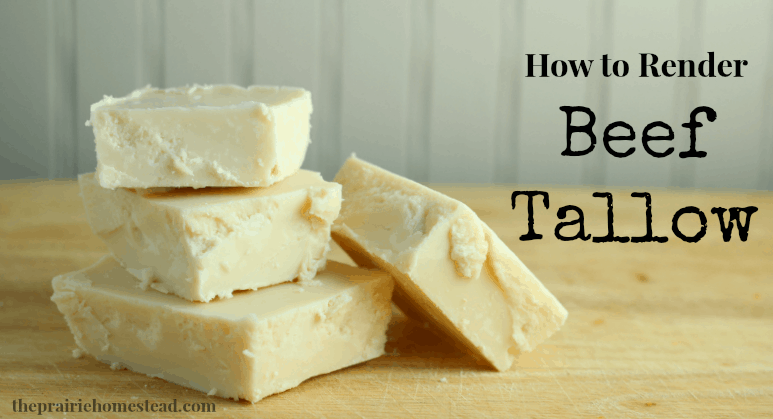
Need an entertaining conversation starter with your non-homesteading friends?
Try mentioning that you rendered beef tallow last week….The reactions will likely range from shock, to disgust, to confusion, to blank stares because they have no idea what the heck you are talking about.
What is Beef Tallow?
Tallow is simply beef fat that has been rendered (cooked down) to remove impurities.
Rendered beef or sheep fat is called tallow.
Rendered pig fat is called lard.
Rendered chicken fat is called schmaltz.
Rendered butter (aka clarified butter) is called ghee.
Tallow is a traditional fat that has been used for centuries, though it felt out of style when vegetable oils came onto the scene. However, thanks to homesteading and interest in more traditional diets, it's quickly coming back into vogue. Hallelujah. And it's one of those homestead skills I think everyone should have in their repertoire.
(By the way, if you'd like to learn more Heritage cooking skills from me, make sure you check out my Heritage Cooking Crash Course…).
The Benefits of Beef Tallow
- Tallow a source of conjugated-linoleic acid (CLA), a fatty acid which studies have shown to help in increasing fat loss. (Source)
- It's rich in vitamins A, D, E, and K, which are excellent for your skin.
- It has a high smoke point and is more stable than processed vegetable oils.
- You can grow, harvest, and render tallow right in your kitchen. This makes it a more sustainable, local option for cooking fats.
The Health Benefits of Tallow:
Tallow is an excellent source of niacin, vitamins B6, B12, K2, selenium, iron, phosphorus, potassium and riboflavin. Grassfed beef tallow contains high ratio of conjugated linoleic acid (CLA) which is a cancer-resistant agent. Contrary to the popular conception, tallow is good for health as tallow fat is similar to the fat/muscles in the heart. Recent studies have shown that human beings need at least 50% of saturated fats like tallow and lard to keep the heart pumping hard and healthy. Tallow from pasture-raised cows also contains a small amount of Vitamin D, similar to lard.Source
How to Use Beef Tallow
Oh man, where do I even start?
Hands down, homemade French fries are my favorite way to use beef tallow. (Did you know that McDonald's used to fry their French fries in tallow back in the day? That is, before they got "healthy" and switched to hydrogenated vegetable oils….)
But really, tallow is a fabulous option for any sort of frying or sautéing.
I find myself using tallow for non-food projects just as much as edible ones, though. Tallow is my go-to material for homemade tallow soap and mason jar candles, as it's readily available (in my freezer!) and very affordable.
How to Find Beef Fat to Render into Tallow
We prefer tallow made from the "leaf fat" of a cow, which is the mass of fat found around the kidneys. Leaf fat produces a cleaner, milder tasting tallow.
If you are butchering yourself, you'll find the leaf fat in a big mass around the kidneys. It has a cellophane-ish coating on it and feels kind of waxy. It was fairly easy to pull the whole she-bang out of the carcass and I plopped it into a bucket to refrigerate until the next day after we had the bulk of the meat cut up.
When we take our steers to the local butcher, I simply ask them to save the leaf fat for me. They usually happily oblige, and I end up with a bag of frozen fat chunks when we pick up our finished beef.
If you don't raise your own beef, give your local butcher shop a call anyway. Odds are that they'll be willing to save the leaf fat from another animal for you for a small fee. (It's not exactly a highly-sought after item in most areas, so don't be surprised if you get some raised eyebrows…)
How to Render Tallow
You will need:
- Quality beef fat (also known as suet)-
- A large stock pot OR slow cooker
- Clean glass jars for storage (wide mouth work best)
- Cheesecloth or improvised cheesecloth alternative
Instructions:
If you are butchering the animal yourself, you'll find the leaf fat in a big mass around the kidneys. It has a cellophane-ish coating on it and feels kind of waxy. It was fairly easy to pull the whole she-bang out of the carcass and I plopped it into a bucket to refrigerate until the next day.
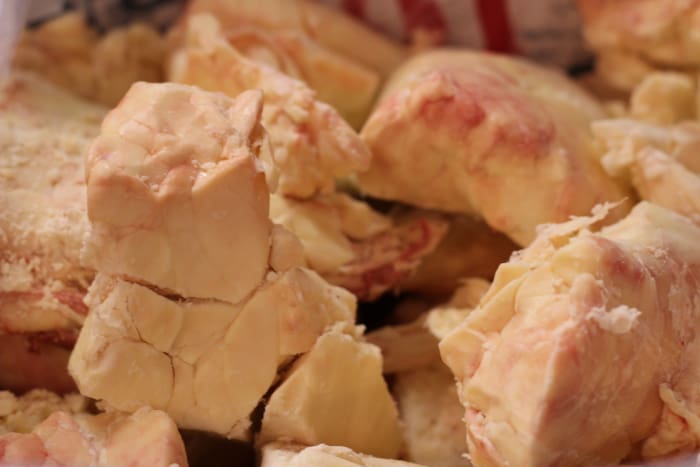
Rendering tallow is NOT difficult, however, it can take a little bit of time. From the research I've done, there seems to be two methods: wet rendering (where you add some water to the pot), and dry rendering (no water.) I chose to go with the dry method, as it just seemed simpler and there is less concern about the fat going rancid.
First things first, you'll need to trim the beef fat. I highly recommend starting off with cold fat, as it's MUCH easier to handle. I refrigerated mine overnight and it was about the consistency of cold butter when I started working with it. Perfect.
Chop it into manageable chunks, then trim off bits of meat, blood, gristle, or whatever else you may find.
Since I used the leaf fat from around the kidneys, I had far less trimming to do than if I had chosen fat from elsewhere on the animal. I did have to cut the kidneys out of the middle of the fat mass, but the rest of the trimming was minimal.
The leaf fat has a weird sort of "cellophane" wrapping around it. I pulled off as much as I could, but there was no way I could get every little piece. Just do the best you can, and the rendering process will cook out the rest.

(Your fat most likely will not be this yellow. Dairy cows, like Jerseys and Guernseys, have bright yellow fat.)
Once you have everything trimmed, run the fat through the food processor (again, MUCH easier if it's cold!) until it is the consistency of ground meat. If you don't have a processor, you can simply chop the fat into small pieces, but shredding it makes the rendering process go much faster.
Dump the shredded fat into a slow cooker or a large stockpot. Begin melting it at very low heat. It will take a while, but you most definitely do NOT want to burn it.
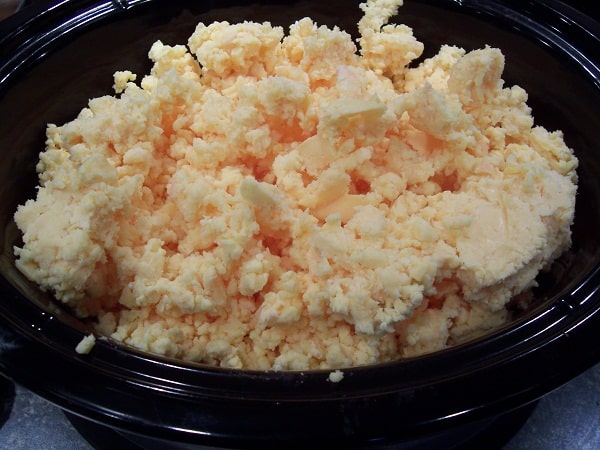
Now, it's just a waiting game. It will probably take several hours, depending on how much fat you are rendering. I had my 6-quart crockpot full, and it took 5-6 hours to render. Check the fat occasionally for burning and give it a stir when you think about it.
As the fat renders, it will slowly begin to melt and allow the "impurities" to rise to the top.

You'll know it's done with there is clear liquid at the bottom and crispy bits floating on top.
Strain the tallow through a piece of cheesecloth or fabric or a fine mesh strainer. You want to remove all of the "floaties", so you will definitely need something more than a colander here (although you may want to place your cheesecloth inside a colander to make the straining easier).

Pour into your jars OR line baking pans with parchment paper or waxed paper and pour the liquid fat into the pans. Allow it to harden completely. If you are using fat from a beef-breed animal (Angus or Hereford for example), your tallow should turn a creamy white as it cools.
If the fat is from a dairy breed, then it's likely the hardened tallow will be bright yellow. Neither one is better or worse–just different.
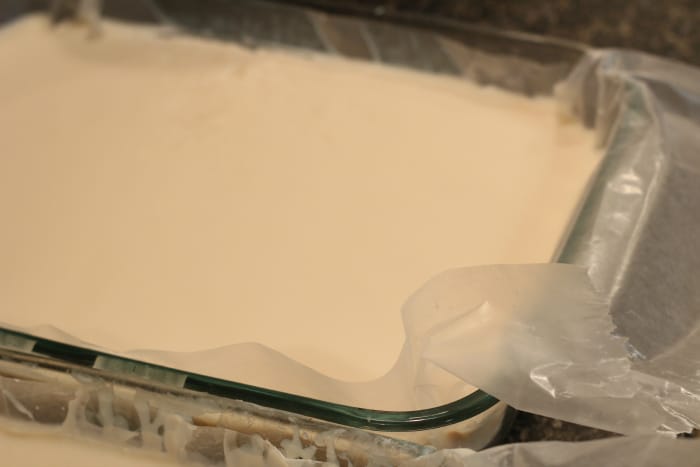
Once the tallow has hardened, you can chop it into bars (if you use pans). A lot of folks store their tallow in their pantry at room temp, but I usually refrigerate mine. If you are interested in even longer storage, it can be frozen.
Your rendered tallow should last quite a long time in the refrigerator and freezer. (Mine has lasted well over a year)
FAQs:
What's the best temperature for rendering tallow?
The lower the better! Resist the urge to speed up the process, as it's easy to scorch the rendering fat, which will result in a strong, unpleasant aftertaste.
How do I render tallow on my stove?
The method is exactly the same as using a slow cooker– just be sure to keep the burner on LOW and check frequently to make sure you're not burning it.
Does tallow have a gross taste or smell when you use it?
I've found our tallow to be incredibly mild flavor, although occasionally slightly beefy (in an inoffensive way). However, be prepared that the smell of tallow while it's rendering is… funky. Thankfully, that aroma isn't carried over into the finished product.
It's REALLY hard to get my finished tallow out of the jars. Help!
I've found tallow to be much harder than lard– and when it's cold, it's nearly impossible to chip it out of a mason jar. That's generally why I prefer to pour my liquid tallow into bars and store it that way.
Can I reuse my tallow after frying?
Absolutely! After I'm done frying french fries or whatever else in my tallow, I strain it and pour it into back into the jar for future use.
Can I use this same method to render my own lard?
Yes. This same rendering method is exactly the same for rendering lard.
I don't want to mess with rendering tallow myself. Where can I buy it?
The problem with tallow and lard is they can be somewhat hard to find, especially in conventional grocery stores.(Avoid the run-of-the-mill lard you'll find in most conventional grocery stores… It's usually hydrogenated and just as bad for you as vegetable shortenings…).
Fortunately, there are a handful of companies who have popped up in recent years who are manufacturing high-quality, grass-fed beef tallow. I suggest trying Ancestral Supplements Beef Tallow or Epic Grassfed Tallow. (affiliate links)
Listen to the Old Fashioned On Purpose podcast episode #33 on the topic Three Fats You'll Never Find in my Kitchen (and what I use instead) HERE.
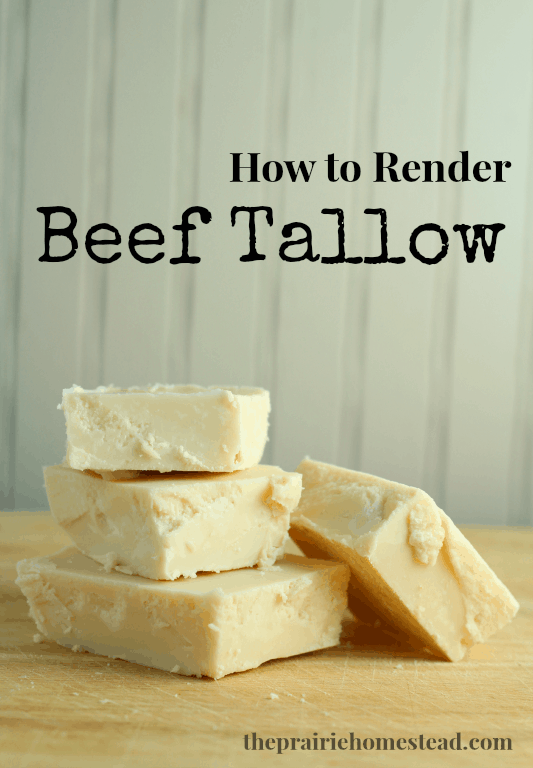
Source: https://www.theprairiehomestead.com/2012/02/how-to-render-beef-tallow.html
0 Response to "Is It Possible to Re-render Beef Fat?"
Post a Comment